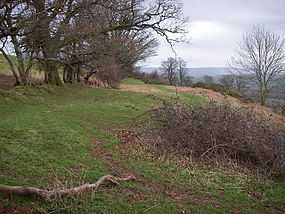Slwch Tump
| Slwch Tump | |
|---|---|
|
This level bench in the hillside is the southern edge of Slwch Tump hillfort | |
 Slwch Tump in Powys, Wales | |
| Alternate name | Pen Cevn-y-Gaer |
| Coordinates | 51°56′46″N 3°22′29″W / 51.946059°N 3.37483°W |
| Type | defended enclosure[1] |
| Length | 187 m[1] |
| Width | 242 m[1] |
| History | |
| Periods | Iron Age |
| Site notes | |
| Public access | accessible by public right of way[2] |
Slwch Tump, also known as Slwch Camp and formerly known as Pen Cevn-y-Gaer,[3] is an Iron Age hill fort close to Brecon in Powys, Wales.
Site
The enclosure is located on a hill composed of sandstones of the St Maughans Formation[4] with an elevation of 807 ft (246 m), about 0.8 miles (1.3 km) east of the confluence of the Rivers Usk and Honddu in the centre of Brecon.[1] The hill fort can be accessed by a public footpath which joins Slwch Lane north of the site and loops around the rampart.[2]
Description
The hill fort is smaller than the one on nearby Pen-y-crug[3] and is irregular but roughly rectangular in shape, measuring about 187 m by 242 m, with a single encircling rampart.[1] Samuel Lewis described it in 1845 as "defended by a double fosse, which is in some places nearly destroyed".[3] Its entrance is on the north-west side, towards Brecon.[1]
Today its form is somewhat obscured by hedges and trees.[2] Within the hill fort area there are remains of abandoned quarries for building stone.[5]
St Eluned
A small church stood for some time at Slwch Tump, marking the place where Saint Eluned was supposedly beheaded. Eluned was one of the daughters of the 5th-century King Brychan of Brycheiniog and, as a Christian, she refused a pagan prince's marriage proposal and fled from him. At Slwch Tump, the local lord permitted her to build herself a cell, where she lived until her spurned suitor found her. As she ran from him, he cut off her head with his sword. A spring of water appeared and her cell became a small church, which remained on the site, latterly in a ruinous state, until 1698.[6] Before the Reformation, the spring was associated with healing and other miracles.
References
- ↑ 1.0 1.1 1.2 1.3 1.4 1.5 J.Wiles (24 July 2002). "Slwch Camp; Slwch Tump; Ginger Wall". Royal Commission on the Ancient and Historical Monuments of Wales. Retrieved 17 November 2012.
- ↑ 2.0 2.1 2.2 "Iron Age". Fforest Fawr Geopark. Retrieved 17 November 2012.
- ↑ 3.0 3.1 3.2 Samuel Lewis (1845). A topographical dictionary of Wales,: comprising the several counties, cities, boroughs, corporate and market towns, parishes, chapelaries, and townships, with historical and statistical descriptions: embellished with engravings of the arms of the bishoprics, and of the arms and seals of the various cities and municipal corporations: and illustrated by maps of the different counties. S. Lewis. p. 421. Retrieved 17 November 2012.
- ↑ "Brecon". Fforest Fawr Geopark. Retrieved 17 November 2012.
- ↑ "Historic Landscape Characterisation - Middle Usk Valley - Brecon and Llanddew communities, Powys". Clwyd-Powys Archaeological Trust. 19 June 2012. Retrieved 17 November 2012.
- ↑ David Hugh Farmer (23 September 2004). The Oxford Dictionary Of Saints. Oxford University Press. p. 56. ISBN 978-0-19-860949-0. Retrieved 17 November 2012.
